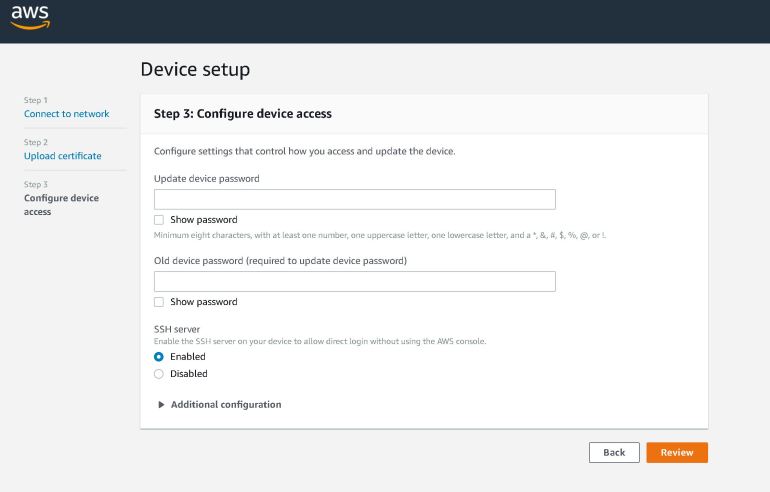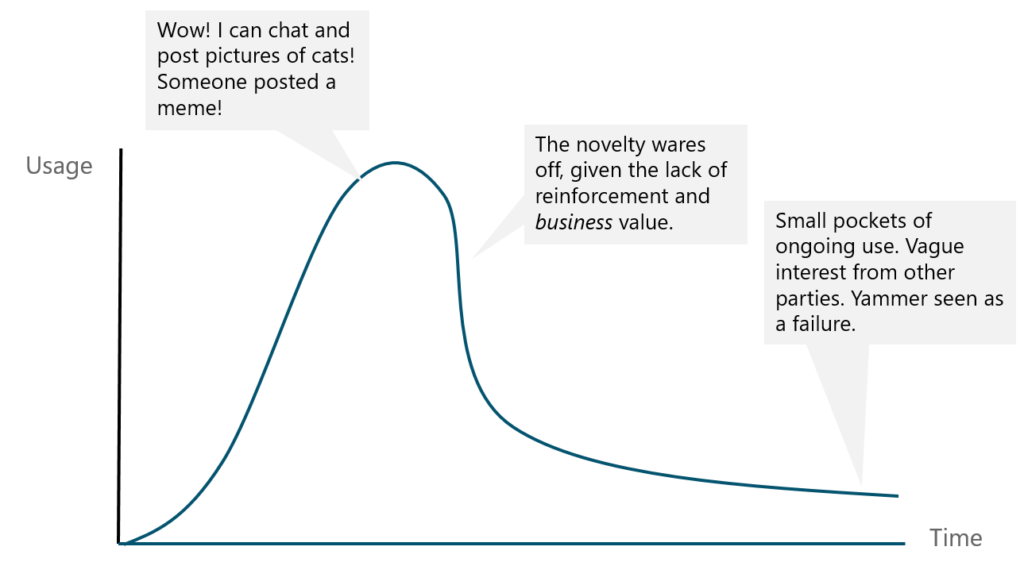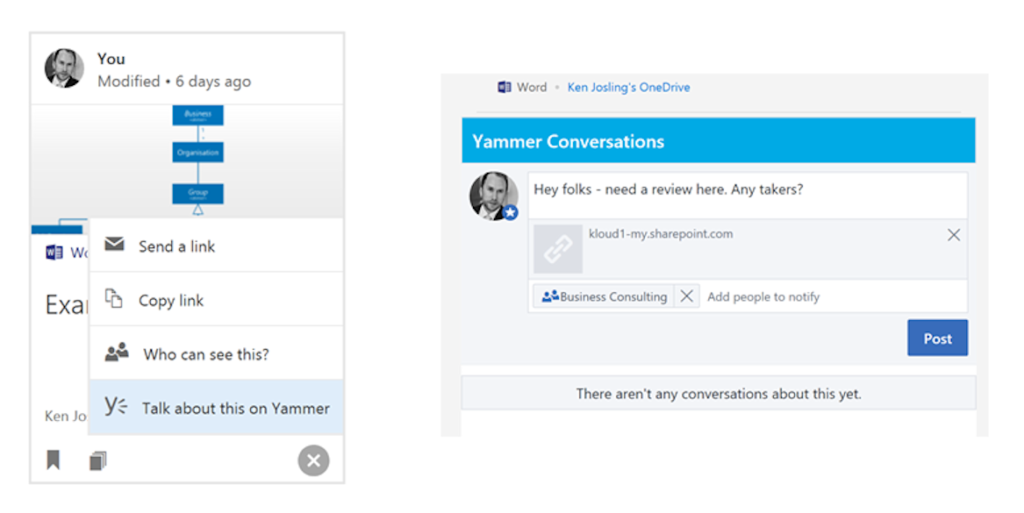
Taking my inspiration from Comedy Central, the Yammer Roast is a forum in which we can directly address resistances around Yammer, its role, and past failures in retrospect.
Some of my clients have tried with Yammer and concluded that for various reasons it’s failed to take hold. For some the value is clear and it’s a case of putting a compelling approach and supporting rationale to sponsors and consumers who remain sceptical. For others, they are looking for a way to make it work in their current collaboration landscape.
The Yammer roast is designed to tease out, recognise and address key resistances. It’s not an opportunity to blindly evangelise Yammer; it’s an exercise in consulting to provide some clarification around Yammer as a business solution, and what’s needed for a successful implementation.
In this article, I’ll cover some of the popular resistances aired at Yammer Roasts, why these resistances exist and how you can address them. If you’re an advocate for social networking in your own organisation, my hope is that this can inform your own discussion.
- We have concerns over impropriate usage, distraction from proper work
There’s a perception that Yammer is a form of distraction and employees will be off posting nonsense on Yammer instead of doing proper work. Even worse, they may be conducting themselves inappropriately.
A self-sustaining Yammer network has to find that balance between [non-work stuff] and [work stuff], and it needs an element of both to be successful. Informal, social contributions beget more meaningful work contributions.
Consider what is perceived as informal, non-work-stuff to be valuable. That person who just posted a cat picture? They are adopting your platform. As are those people who liked or commented on it. Consider the value to the organisation if people are connecting with each other and forming new relationships, outside of the confines of an organisational hierarchy.
Assume your employees know how to conduct themselves and can practice good netiquette. They signed a contract of employment which includes clauses pertaining to code of conduct. Perhaps refer to that in your terms of use.
Establish a core principal that no contribution should be discouraged. It really doesn’t matter where content in Yammer is generated, and any one person’s view of the content is informed by who they follow, the groups they subscribe to and the popularity of content. Uninteresting, irrelevant content is quickly hidden over time. “But what if someone puts a cat picture in the All Company feed?” So what? What if the CEO likes it? Consider creating a foundational set of groups to ensure that on day one there’s more than just the All Company feed.
Strike that balance between work-stuff and non-work stuff. Set an objective for your community manager (yes, a formal responsibility!) to help combat potential stage fright; there are numerous incentives and initiatives that can come into play here. Accept the fact that your social network will, and should, grow organically.
- We’ve got Yammer and no-one is using it.
…but your partners and vendors are and they’re looking to collaborate with you.
Stagnant networks; a common scenario. Your organisation may be looking at alternative platforms as a way to reset/relaunch. Here, you lament the lack of tangible, measurable business outcomes at the outset of the initial rollout or the lack of investment in change management activities to help drive adoption of the platform.
You’ll smile and nod sagely, and perhaps talk to a view similar to the following:

But, for whatever reason, you’re here. So how can past experiences inform future activities?
Whether you use Yammer or not, the success of your social network in its infancy is dependent on measurable business outcomes. Without the right supporting campaign, a way to track adoption and a way to draw insight from usage, you effectively roll the dice with simply ‘turning it on’. Initiatives around Yammer can start small with a goal of communicating the success (of a process) and subsequently widening its application within your business.
Simply swapping out the technology without thinking about the business outcome may renew interest from sponsors who’ve lost faith in the current product, but you risk a rinse and repeat scenario.
“But we’re dependent on executive sponsorship!” I hear you lament. This is a by-product of early boilerplate change campaigns, where success somehow rested on executives jumping in to lead by example. Don’t get me wrong, it’s great when this happens. From my perspective, you need any group within your business with a value use case and the willingness to try. You have O365, the technology is there.
You can consider the Yammer client to not just be a portal into your network, but the networks of your vendors and partners. Access to your partner/vendor product teams (via Yammer External Networks) and being able to leverage subject matter expertise from them and the wider community is a compelling case in the absence of an internal use case.
Combatting any negative perceptions of your social network following a failure to launch is all about your messaging, and putting Yammer’s capability into a wider context, which leads me to…
- But we’re using Teams, Slack, Jabber, Facebook for Workplace (delete as appropriate)
Feature parity – it can be a head scratcher. “But we can collaborate in Skype. And Teams! And Yammer! And via text! What will our users do?” Enterprise architects will be advocating the current strategic platform in the absence of a differentiator, or exception. Your managed services team will be flagging additional training needs. There will be additional overheads.
If you’re there to champion Yammer in the face of an incumbent (or competing) solution, you need to adopt the tried and tested approach which is 1. Identify the differentiator and align the new technology (i.e. Yammer) to it, 2. Quantify the investment, and 3. Outline the return on investment.
As a consultant my first conversations are always focused around the role Yammer will play in your organisation’s collaboration landscape. The objective is to ensure initial messaging about Yammer will provide the required clarity and context.
This reminds me of an engagement some time ago; an organisation with a frontline workforce off the radar forming working groups in Facebook. “We aren’t across what’s going on. We need to bring them over to Yammer.” Objective noted, but consider the fact that a) these users have established their networks and their personal brand, b) they are collaborating in the knowledge that big brother isn’t watching. Therefore, there’s no way in hell they’ll simply jump ship. The solution? What can you provide that this current solution cannot? Perhaps the commitment to listen, respond and enact change.
The modern digital workplace is about choice and choice is okay. Enable your users to make that informed decision and do what is right for their working groups.
- It’s another app. There’s an overhead to informing and educating our business.
Of course there is. This is more around uncertainty as to the strategy for informing and educating your business. Working out the ‘what’s in it for me?’ element.
There is a cost to getting Yammer into the hands of your workforce. For example, from a technical perspective, you need to provide everyone with the mobile app (MAM scenarios included) and help users overcome initial sign-in difficulties (MFA scenarios included). Whatever this may cost in your organisation, your business case needs to provide a justification (i.e.) return on that investment.
Campaign activities to drive adoption are dependent on the formal appointment of a Community Manager (in larger organisations), and a clear understanding around moderation. So you do need to create that service description and governance plan.
I like to paint a picture representing the end state – characteristics of a mature, self-sustaining social network. In this scenario, the Yammer icon sits next to Twitter, Instagram, Facebook on the mobile device. You’re a click away from your colleagues and their antics. You get the same dopamine rush on getting an alert. It’s click bait. God forbid, you’re actually checking Yammer during the ad-break, or just before bed time. Hang on, your employee just pointed someone in the right direction, or answered a question. Wait a second! That’s voluntarily working outside of regular hours! Without pay!
- Yammer? Didn’t that die out a few years ago?
You’ve got people who remember Yammer back in the days before it was a Microsoft product. Yammer was out there. You needed a separate login for Yammer. There were collaboration features built into Microsoft’s SharePoint platform but they sucked in comparison, and rather than invest in building competitive, comparative features into their own fledgling collaboration solution, Microsoft acquired Yammer instead.
Roll out a few months, and there’s the option to swap out social/newsfeed features in SharePoint for those in Yammer, via the best possible integration at the time (which was essentially link replacement).
Today, with Office 365, there’s more integration. Yammer has supported O365 sign-in for a couple of years now. Yammer functions are popping up in other O365 workloads. A good example is the Talk about this in Yammer function in Delve, which then frames the resulting conversation from Yammer within the Delve UI:  From an end user experience perspective there is little difference between Yammer now and the product it was pre-Microsoft acquisition, but the product has undergone significant changes (external groups and networks for example). Expect ongoing efforts to tighten integration with the rest of the O365 suite, understand and address the implications of cutting-off that functionality.
From an end user experience perspective there is little difference between Yammer now and the product it was pre-Microsoft acquisition, but the product has undergone significant changes (external groups and networks for example). Expect ongoing efforts to tighten integration with the rest of the O365 suite, understand and address the implications of cutting-off that functionality.
The Outcome
Yammer (or your social networking platform of choice) becomes successful when it demonstrates a high value role in driving your organisation’s collaborative and social culture. In terms of maturity we’re taking self-sustaining, beyond efforts to drive usage and lead by example.
Your social network is an outlet for everyone in your organisation. People new to your organisation, will see it as a reflection of your collaborative and social culture; give them a way to connect with people and immediately contribute in their own way.
It can be challenging to create such an outlet where the traditional hierarchy is flattened, where everyone has a voice (no matter who they are and where they sit within the organisation). Allowing online personalities to develop without reluctance and other constraints (“if it’s public, it’s fair game!”) will be the catalyst to generating the relationships, knowledge, insight (and resulting developments) that will improve your business.
